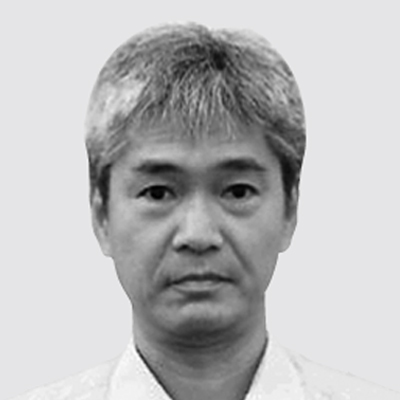Hitachi is working to further expand its Social Innovation Business, with global business operations and the strengthening of its digital foundations serving as key pillars of growth. Meanwhile, Hitachi is also seeking to establish flexible MONOZUKURI operation practices that provide flexibility in where to conduct design and production work across its manufacturing operations that extend globally, engaging in company-wide activities for strengthening MONOZUKURI capabilities through the introduction of digital technology.
Here, articles describe Hitachi’s MONOZUKURI operation practices that utilize digital transformation, including enhancements to engineering chain management and supply chain management systems and the strengthening of core manufacturing technologies and human capital development.



Manufacturing, especially in the social infrastructure business, has in recent years become increasingly globalized based on growth strategies that target the huge demand for infrastructure in emerging nations, with government providing support(1). When looked at in terms of MONOZUKURI (manufacturing) practices, however, issues such as rising wages and problems with quality management in emerging nations have prompted moves to review the model of overseas expansion based on low-cost production in China and Southeast Asia that to date has been the predominant route followed by Japanese companies(2).
Meanwhile, the progress of digital technology has been remarkable and has been accompanied by an acceleration of moves to utilize cyber-physical systems (CPSs) in MONOZUKURI operation in pursuit of objectives such as Industrie 4.0(3) or Connected Industries(4). The sensing and other technologies used in the Internet of Things (IoT) are enabling the capture as digital data of things that in the past could not be expressed numerically, such as the flow of parts or the behavior of workers, not just production equipment. Moreover, using this digital information as its inputs, work is proceeding on the research and development of artificial intelligence (AI) to enable formalization of the tacit knowledge that has come to be embodied in the experience and intuition of skilled staff(5).
As indicated in its 2018 Mid-term Management Plan(6), Hitachi plans to further expand its Social Innovation Business, with the worldwide operation of its businesses (including in Europe and North America) and the strengthening of their digital underpinnings as key pillars of this growth. MONOZUKURI operation practices will also need to be reformed in ways that facilitate this business growth strategy.
As shown on the left of Figure 1, Hitachi's overseas manufacturing plants have traditionally operated either as an export model, as a means of supplying local demand, or as a low-cost means of production, with business practices that for the most part have involved products and design drawings being handed down from mother factories, that is, main factories in Japan to regional operations. Now, however, Hitachi is pursuing a global expansion strategy that looks to involve the acquisition of overseas companies or collaboration with overseas partners in anticipation of dramatic growth in global business. One of the challenges of mergers and acquisitions (M&A) is the post-merger integration (PMI), and MONOZUKURI, too, needs to make allowance for PMI in its plans for the future.
As it seeks to establish highly efficient MONOZUKURI operations throughout the world, Hitachi is taking steps to establish flexible MONOZUKURI operation practices (a framework for next-generation MONOZUKURI) that provide flexibility in where to conduct production and design work, whether it be at an acquired company's sites or at existing Hitachi operations as shown on the right of Figure 1. Meanwhile, the ability to manufacture products with high quality and reliability, quickly and at low cost, is the source of Hitachi's competitive advantage. Safety, quality, cost, and delivery (SQCD*) have long been a priority at Hitachi, and another key focus is to establish the core fundamentals for MONOZUKURI operation so as to rank among the top global companies on these criteria.
Figure 1—Global MONOZUKURI Hitachi is taking steps to shift away from a practice of one-way communications from main factories in Japan to regional operations, instead adopting flexible MONOZUKURI operation practices that provide flexibility in where to conduct design and production work across acquired companies’ sites and existing Hitachi plants.
Hitachi is taking steps to shift away from a practice of one-way communications from main factories in Japan to regional operations, instead adopting flexible MONOZUKURI operation practices that provide flexibility in where to conduct design and production work across acquired companies’ sites and existing Hitachi plants.
This section describes work on strengthening MONOZUKURI capabilities with the aims of establishing flexible MONOZUKURI operation practices and become a global leader in the core fundamentals for MONOZUKURI operation.
Figure 2 shows a diagram of how Hitachi intends to go about these activities. Corporate divisions will have a central role in the work, formulating strategies and key measures for strengthening MONOZUKURI capabilities and then deploying these at the various business units (BUs) and group companies. In the case of corporate divisions, the MONOZUKURI Strategy Division (which coordinates activities) works with divisions responsible for research and development (which deals with the development of advanced technology), training (which builds human capital), information systems (which has responsibility for making company IT systems more advanced), and digital engineering (which handles the roll-out of digital solutions) to formulate and deploy measures suitable for widespread use that address the key challenges facing Hitachi from a variety of standpoints. The deployment of measures at each BU and group company is handled in an effective manner by adopting different ways of going about things like consulting, operational support, and information sharing depending on the particular issues that exist.
Table 1 lists the objectives and actions for three of the projects for strengthening MONOZUKURI capabilities that form part of the activities while Figure 3 shows the role each one plays in the end-to-end (E2E) manufacturing value chain. The following sections describe the actions being taken in each project.
Figure 2—Scheme for Strengthening MONOZUKURI Capabilities The MONOZUKURI Strategy Division works together with research and development, training, information systems, and digital engineering divisions to formulate and deploy measures for strengthening MONOZUKURI capabilities that are suitable for widespread use within Hitachi from a variety of standpoints.
The MONOZUKURI Strategy Division works together with research and development, training, information systems, and digital engineering divisions to formulate and deploy measures for strengthening MONOZUKURI capabilities that are suitable for widespread use within Hitachi from a variety of standpoints.
Figure 3—Roles of Projects for Strengthening MONOZUKURI Capabilities in Value Chain The three MONOZUKURI capability strengthening projects (upgrading ECM systems, upgrading SCM systems, and strengthening core manufacturing technologies and human capital development) are respectively targeted at development and design, the supply chain, and production.
The three MONOZUKURI capability strengthening projects (upgrading ECM systems, upgrading SCM systems, and strengthening core manufacturing technologies and human capital development) are respectively targeted at development and design, the supply chain, and production.
Table 1—Objectives and Actions for Projects for Strengthening MONOZUKURI Capabilities To strengthen MONOZUKURI capabilities, Hitachi is working on projects to upgrade ECM systems, upgrade SCM systems, and strengthen core manufacturing technologies and human capital development.
To strengthen MONOZUKURI capabilities, Hitachi is working on projects to upgrade ECM systems, upgrade SCM systems, and strengthen core manufacturing technologies and human capital development.
The project to upgrade engineering chain management (ECM) systems involves standardization of development and design processes and sharing of information in order to ensure that such work can proceed smoothly and efficiently across sites located in different parts of the world.
Modular design (MD) is a way of making the adoption of standardized components across different products more efficient by pre-defining the level of component standardization, with customized design only being used to deal with differences that arise out of a customer's particular requirements(7). While Hitachi has been working since 2012 to adopt MD throughout its operations, this project accelerates progress by extending the practice to overseas sites.
Furthermore, three-dimensional (3D) models define and collate product information such as production and inspection instructions together with 3D computer-aided design (3D-CAD) shape information. Hitachi is proceeding with development and design process reforms that treat these 3D models as the originals to facilitate the smooth exchange of information with sites throughout the world. Doing so not only reduces the amount of conversion work required with past processes that used a mix of 2D and 3D, it also makes possible efficient design and sophisticated ways of using them outside of design, with the use of 3D model/assemble functions to generate engineering bills of materials (E-BOMs), and the subsequent production of a manufacturing BOM (M-BOM). There have been instances where BUs or group companies that make active use of 3D models have made significant reductions in total lead time through the adoption of concurrent design based on the shared use of these models across the various processes of production design, production, inspection, procurement, and maintenance.
This unobstructed sharing of design information between sites located throughout the world that is made possible by the use of 3D models and the coordination with the upgrade project for supply chain management (SCM) systems are both important factors in achieving crowd manufacturing(8), an initiative that is currently proceeding in parallel across different parts of Hitachi.
The project to upgrade SCM systems, meanwhile, is following the roadmap shown in Figure 4 to achieve the end-to-end standardization and digitalization of SCM operations while also strengthening the exchange of information, with the objective of optimizing things like production lead times and inventory levels throughout the supply chain. In this case, “end-to-end” means that the project covers all regions, the entire product life cycle, and every step along the value chain.
One example of the work being done to overcome the distances between regions is the real-time interlinking of information on production, sales, and inventory (PSI) across sites in different parts of the world. The intention is to shorten lead times and enable more sophisticated inventory management by synchronizing this information across the different operations. This is also made available to external users via Hitachi's TWX-21 business-to-business trading service in the form of the global PSI visualization service, a cloud-based service for coordinating production and sales across sites that operate different core IT systems(9).
In the case of work that relates to the product lifecycle, along with the development of a way of predicting spare parts demand to help rationalize the cost of providing maintenance services over long time periods, this also includes adopting methods for evaluating the cost of inventory that incorporate indicators such as the ratio of gross profit to inventory investment and its net present value (NPV) based on how long the inventory is to be held.
Hitachi is also working on sophisticated ways of utilizing digital information in order to optimize all areas of the value chain, shortening total lead times through the interoperation of ECM and SCM, making more efficient use of design and production resources through the integrated operation of sites in different parts of the world and the use of predictive simulation, and making productivity improvements through better manufacturing and quality traceability, with the standardization of master data for production and the use of IoT technology to automate the acquisition of production data records playing a pivotal role.
Figure 4—Roadmap for Use of Standardization and IT to Enhance SCM Systems Work on standardization and the introduction of IT is proceeding in a series of defined stages for the automation and system-wide optimization of SCM operation.
Work on standardization and the introduction of IT is proceeding in a series of defined stages for the automation and system-wide optimization of SCM operation.
To utilize its MONOZUKURI capabilities as a basis for global competitiveness, Hitachi is taking steps to strengthen its MONOZUKURI foundations so as to become a global leader in SQCD. This project addresses both the digitalization of machining, casting, welding, coating, and other core manufacturing technologies, and MONOZUKURI human capital development.
In the case of machining, the digitalization of core technologies involves the development of techniques for automatically determining the optimal machining conditions based on data on the tools, workpiece, and materials, and the building of systems that use image processing to digitize the skills of experienced staff in operations such as welding or coating.
In terms of MONOZUKURI human capital development, in addition to running training that utilizes the digitized skills of experienced staff referred to above, Hitachi has also developed and deployed hands-on training in which trainees are able to touch and break down things for themselves, something that is difficult to accomplish in classroom lessons or on-the-job training (OJT), and an industrial engineering (IE) meister certification program for fostering manufacturing workplace supervisors. Figure 5 shows a hands-on training session for machining and Figure 6 gives an overview of the IE meister certification program.
Meanwhile, quality compliance violations, whether intentional or by mistake, are a major threat with the potential to do great harm to the reputation of the entire company. Although Hitachi has for some time conducted ethics training to prevent such problems from happening, it is now augmenting this with digitalization and automation initiatives that provide effective ways of preventing data tampering or misrecording, such as automatically collecting inspection data or automatically checking for compliance with safety standards.
Cyber-attacks such as the WannaCry malware have also become a serious problem in recent years, with the systems targeted by these attacks having expanded beyond office automation to also include those in the manufacturing arena. Hitachi has turned security measures for manufacturing networks, which in the past were handled independently by each site, into a company-wide activity, with actions currently in progress including the development and deployment cybersecurity guidelines that cover all of Hitachi.
Hitachi's Lumada(10) incorporates a collection of use cases (examples of digital innovation from inside and outside Hitachi), of which 74 relate to manufacturing (as of January 2019).
One such is a collaborative creation project involving Okuma Corporation and Hitachi. In this project, a Lumada production planning optimization solution that delivered a 50% reduction in production lead times for key products at Hitachi's Omika Works contributed to the establishment of a next-generation factory at Okuma Corporation that is capable of mass customization(11).
Work on digital transformation described in this article has also been turned into a Lumada use case for achieving best practice through a combination of operational technology (OT) and IT at Hitachi, with the intention of using it widely both within Hitachi and elsewhere.
Hitachi is currently strengthening its MONOZUKURI capabilities to facilitate the further growth of its Social Innovation Business. This involves different parts of Hitachi coming together to work on upgrading ECM systems, upgrading SCM systems, and the strengthening of core manufacturing technologies and human capital development, with the objectives being to establish flexible MONOZUKURI operation practices and become a global leader in MONOZUKURI foundations. Hitachi also anticipates that, through Lumada, the digital transformation initiatives described in this article will also be widely used to enhance MONOZUKURI at many of its customers.